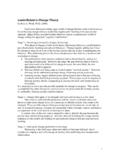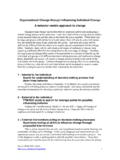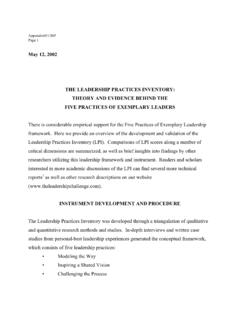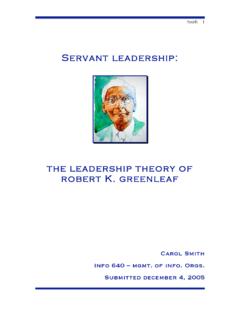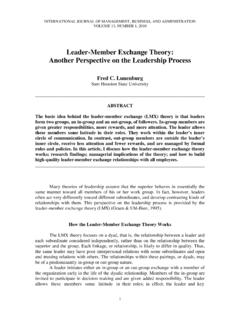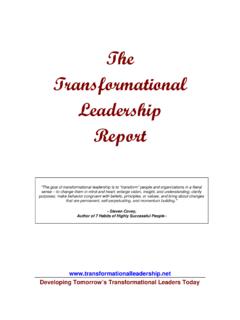Transcription of The DAC (Direction, Alignment, Commitment) framework of ...
1 1 The DAC (Direction, alignment , commitment ) framework of leadership . Drath, et. al. (2008) provides a new generalized model of leadership that also incorporates the traditional leader-follower-goal construction of leadership . Some may find the material a bit heavy, but it is fairly easy to push past some of the wording to grasp the significance of the DAC (direction, alignment , and commitment ) framework of leadership and the impact on leader/ leadership development. The greatest difficulty in reading the article is not the style or content, but the reader s existing paradigm of leadership , which is greatly challenged by the DAC framework of leadership . The DAC framework shifts the focus on leaders acting on followers to the general examination of how groups produce collective outcomes.
2 Once grasped the reader is left with a better theoretical foundation for shared leadership and collective efforts for collaboration. In the DAC framework direction is the overall group mission and goals, alignment is the necessary coordination of action within the collective group, and commitment is the willingness of group members to put personal interests secondary to that of collective interest and benefit. The paradigm shift involves the changed view of leadership where to practice leadership would no longer necessarily involve leaders, followers, and their shared goals but would necessarily involve the production of direction, alignment , and commitment (which may or may not involve leaders and followers) (p.)
3 636). leadership may involve the traditional roles and relationships, but alternate processes may also be involved. Moving to a higher level for examining the production of direction- alignment - commitment permits additional viewpoints on how DAC can be produced. Note, this is not a replacement for the traditional leadership viewpoint, but one that is complementary by proposing there can be multiple ways of accomplishing the outcomes associated with leadership . One paradigm breaking aspect of this approach is the proposition there are different ways to establish leadership and therefore, we need not be constrained by traditional paths. Action toward these ends is already underway in shared and distributed leadership models and new ways of organizing work, which are outside the leader-follower-goal leadership model, but consistent with the DAC framework (as is the traditional leadership model).
4 In this expanded view of leadership , shared leadership is not constructed by a rotating leader role, but something different that is outside the traditional leader-follower dyad even when considering multiple dyad combinations. leadership within a shared context moves beyond rotating asymmetrical influence of others or even mutual influence to a collective engaged in mutual adjustment, shared sense-making, collective learning, or mutual transformation (p. 650). Influence can be seen to be peer-focused in addition to being downward focused. In this DAC viewpoint leadership can result from a system of inter-relating individuals (p. 639) and is not dependent on a single point of leadership . This requires leader competencies distinct from vertical relationships, , bi-lateral relationships that include both influence on and responsibility for results including peer relationships.
5 DAC results are not dependent on asymmetrical influence of a single leader on followers even if the roles are rotated. It is at this point where a theory of leadership blends with team theory. Drawing from elements of complexity science, it might be said that this is both, combining elements of multiple theories into one that is more inclusive of underlying theories. DAC is not a unifying theory, but somewhat closer in that direction than what existed earlier. 2 Complexity also enters into the DAC framework in that something is created that is more than the sum of direction, alignment , and commitment . Each component individually is essential, but not sufficient to produce the leadership effect. Producing DAC requires shared belief in the value of the effort required to accomplish each component of DAC, direction, alignment , and commitment .
6 Agreement on direction may require blending personal goals with those of others, possibly with some element of exchange that is dynamically balanced over time. Maintaining agreed upon direction will require understanding of group direction, but also how that direction relates to individual responsibility in order to clarify requirements for alignment and commitment . alignment may be accomplished through informal agreement or by formal organizational structures, work processes, and reward systems. In this way alignment may be dynamic and fluid in how it is sustained or the structure might be inflexible and difficult to change in response to shifting direction and commitment among group members. commitment requires willingness to subordinate individual goals to the goals of others, thereby establishing mutual commitment toward each other s goals.
7 Even in the most rigid structures, forced compliance (not commitment ) can be met with passive-aggressive behavior to undermine the DAC effect. Effective production of DAC is an on-going effort required by all group members. Individual goals shift, the context outside the group is ever-changing, and the web of group relationships changes with turnover among group membership. However, little depth of theory has been built around the DAC framework , unlike the extensive theory that has developed around each part of the leader-follower-goal model. While a great deal is known about the leader-follower-goal leadership construct, little investigation has been done on the other extreme of distributed leadership where the unit of study is the collective action rather than aggregated, individual actions.
8 The traditional model of leadership is not becoming less true, but is becoming less useful in providing an explanation of what leadership is becoming. As different views of leadership are constructed, there will need to be greater awareness of these possibilities and how they might interact. The collective practice of leadership might evolve from that of personal dominance (a social order based in a single dominant leader) to interpersonal influence (a social order based in exchanges of mutual influence) to relational dialogue (a social order based on mutual transformation). From this perspective, leaders and followers are framed not as essential elements but local-cultural ideas that are socially constructed for the purpose of providing a basis for social cooperation.
9 As such, leaders and followers may become dispensable when the context bearing on social cooperation evolves. (p. 641) At this endpoint of how DAC might evolve as a theory of leadership , interpersonal influence may or may not be involved in leadership as constructed with direction, alignment , and commitment to produce an outcome. This then introduces the impact contextual conditions have on relationships and how they are negotiated over time. Such relational aspects within traditional leadership models are often problematic but can be constructed in DAC leadership as shifting relationships that are framed and reframed over time as context and shared meaning changes. In doing so, context moves from being an 3indirect influence from outside the leader-follower-goal model to being incorporated within the framework of the DAC leadership model.
10 Putting the DAC framework into practice requires a shift in how we think about leadership when moving to the DAC construct. Drath, et. al. (2008) believe this shift is occurring naturally even if not yet widely accepted as a core part of the body of leadership theory. The traditional leadership models are possibilities that will be joined by additional ways DAC might be produced even without requiring leader and follower roles. Raising leadership to a higher level then moves the outcome of leadership from attainment of shared goals to the establishment of the means to attain the outcome. This shift is critical because successfully developing DAC becomes a short-term goal on the path to accomplishing longer-term objectives.
